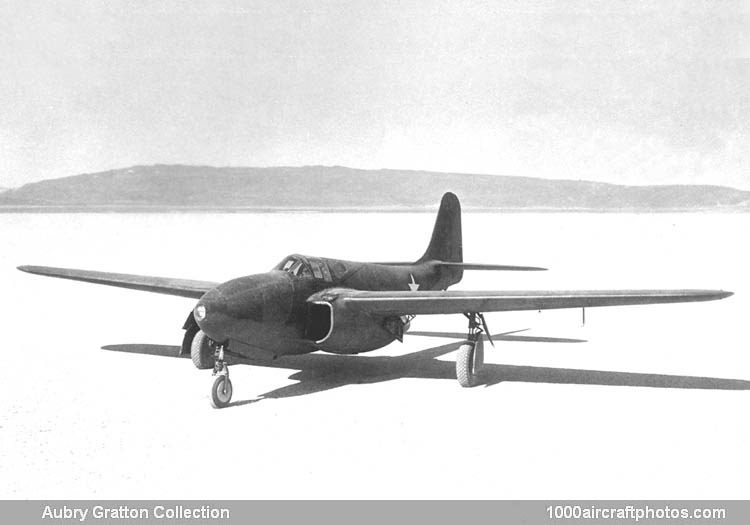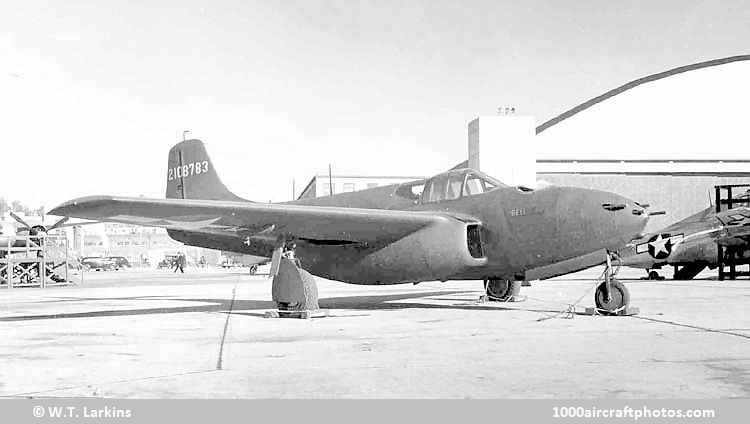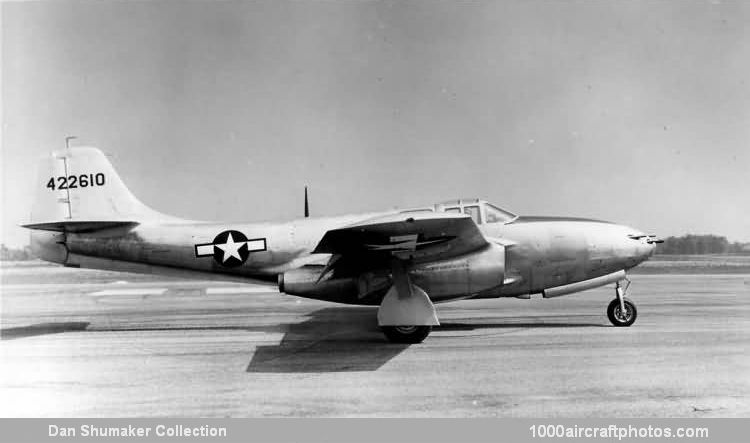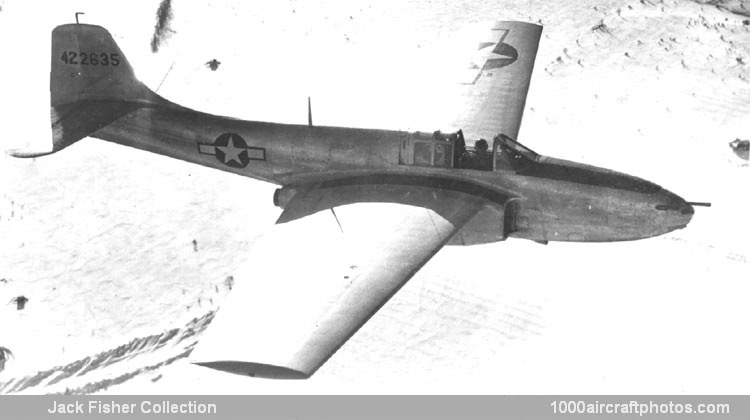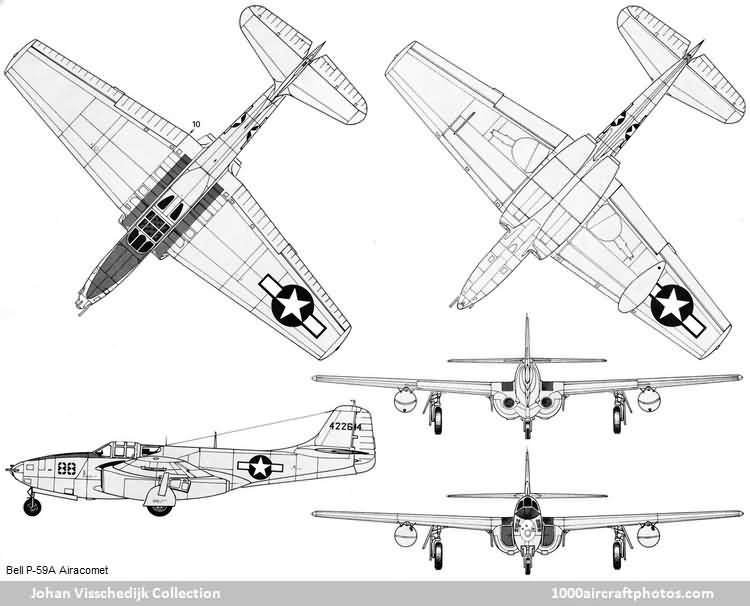12/31/2013. Remarks by
Johan Visschedijk: "The Bell Model 27, or XP-59A Airacomet, was the first turbojet-driven aircraft to be built in the USA, and the first Allied fighter to fly designed from the outset for gas turbines. The contract for the design and construction of the XP-59A was awarded to the Bell company by reason primarily of the location of the concern's plant in close proximity to the General Electric factory engaged in the construction of turbojets based on British Whittle patents.
The designation XP-59A for the new single-seat interceptor fighter and fighter-bomber was selected for security reasons, the XP-59 being a defunct Bell design for a twin-boom pusher fighter powered by an R-2800-23 radial air-cooled engine driving contra-props. A contract for three XP-59A prototypes (serialed 42-108784 to 42-108786) was awarded on September 5, 1941, and construction was undertaken in the strictest possible secrecy.
The three prototypes were each powered by a pair of 1,400 lb (635 kg) st General Electric 1-A turbojets mounted beneath the wing close to the fuselage sides, and the first aircraft was completed in a remarkably short time, accidently flying for the first time during high-speed taxiing tests on October 1, 1942 at Muroc Dry Lake, California. The official first flight was made the following day.
The XP-59A weighed 7,320 lb (3,320 kg) empty and 12,562 lb (5,698 kg) in maximum loaded condition, and carried an armament of two 1.46 in (37 mm) cannon in the fuselage nose. The maximum speed of 404 mph (650 kmh) attained at 25,000 ft (7,620 m) was somewhat below expectations, the engine installation was found to result in an inordinate amount of aerodynamic interference, and the aircraft was subject to "snaking", resulting in a poor gun platform.
YP-59A (42-108783) (
W.T. Larkins Memorial Collection)
However, thirteen service test YP-59As (42-108771 to 42-108783) had been ordered in March 1942, and these were fitted with an improved version of the General Electric engine, the 1-16 (later redesignated J31-GE-3) rated at 1,650 lb (748 kg) st.
The first YP-59A was flown in August 1943, and this showed little improvement in performance over the prototypes. Empty weight was increased by 306 lb (139 kg), and the maximum speed of 409 mph (658 kmh) was attained at 35,000 ft (10,668 m). Cruising speed was 314 mph (505 kmh) and service ceiling was 43,200 ft (13,167 m). The last four YP-59As differed from earlier machines in adopting the trio of 0.50 in (12.7 mm) machine guns and a single 1.46 in (37 mm) cannon standardized for the production P-59A. One YP-59A was delivered to the UK in exchange for the first production Gloster Meteor I, and two were supplied to the USN under the designation XF2L-1, all YP-59As having been accepted by the end of June 1944.
P-59A (44-22610) (
Dan Shumaker Collection)
A production order for 100 P-59A Airacomets had been placed shortly before the first prototype's initial flight, but in view of the disappointing performance of the fighter, this production order was halved on October 30, 1943, by which time the Airacomet was no longer considered as a potential operational type. Bell had already commenced preliminary design studies for a new jet fighter powered by a single General Electric 1-16 turbojet installed in the fuselage and fed via wing root intakes, this being designated XP-59B, but owing to the company's extensive commitments in other directions, the project had been turned over to Lockheed and redesignated XP-80, and the Airacomet was now envisaged as a potential trainer for this type.
Of the fifty production Airacomets, twenty were built as P-59As (44-22609 to 44-22628). These differed little from the YP-59As, although they also could carry two 1,000 lb (454 kg) bombs or eight 60 lb (27 kg) rockets, while performance was very similar. Most P-59As were powered by a pair of J31-GE-3 turbojets, but the last few machines received the up-rated J31-GE-5 of 2,000 lb (907 kg) thrust.
P-59B (44-22635) (
Jack Fisher Collection)
The remaining thirty production Airacomets were built as P-59Bs, these also had J31-GE-5 engines, but internal fuel capacity was increased. Empty weight of the P-59B was increased to 8,165 lb (3,704 kg), and normal and maximum loaded weights were 11,040 lb (5,008 kg) and 13,700 lb (6,214 kg) respectively.
Deliveries of the Airacomet were completed by May 1945. The aircraft had not been a success as a warplane, but it had proved valuable in providing the USAAF with orientation experience with jet aircraft, and in furnishing a nucleus of trained jet pilots."
The following data relate to the J31-GE-5-powered P-59A Airacomet.
